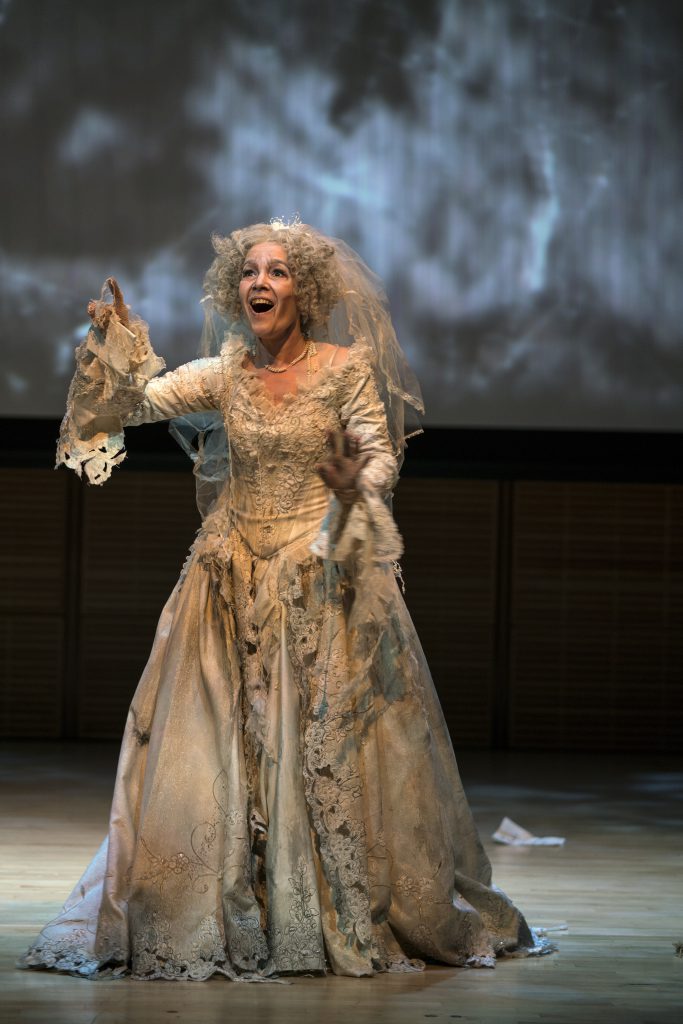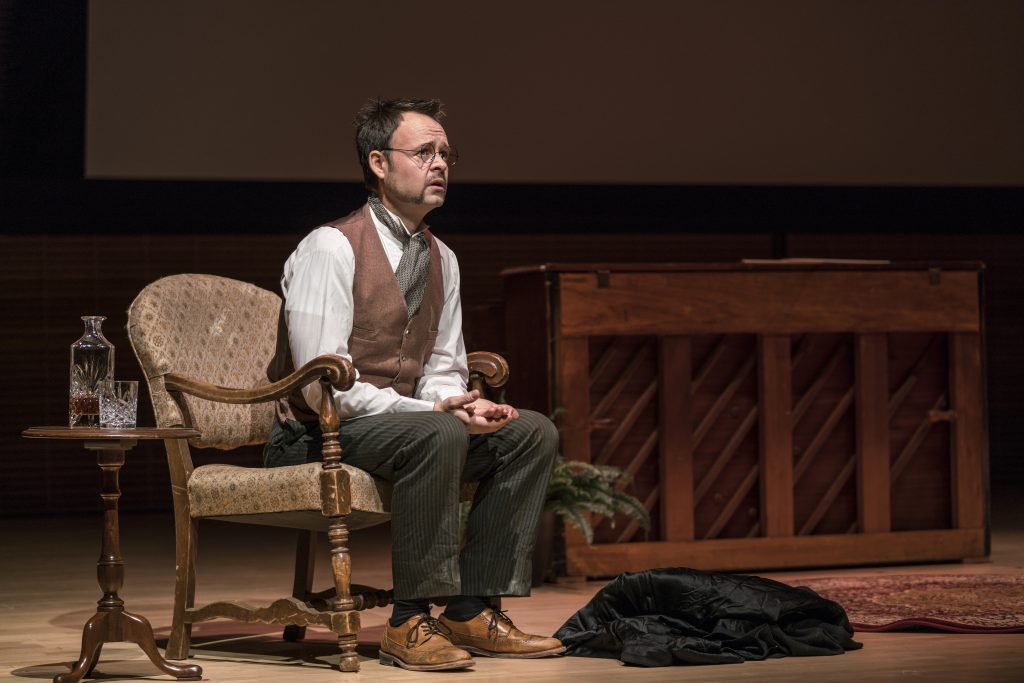NYCO celebrates Argento at 90 with two tragicomic character portraits

Heather Buck performed “Miss Havisham’s Wedding Night” at New York City Opera’s 90th birthday concert for composer Dominick Argento Thursday night at Zankel Hall. Photo: Sarah Shatz
The new incarnation of New York City Opera seems intent on flaunting its versatility. The company has performed in a variety of performance spaces in its two-year renaissance, and on Thursday added Zankel Hall to its growing list of venues, performing two one-act monodramas to honor the 90th birthday of the American composer Dominick Argento.
Thursday’s Argento appreciation opened, appropriately, with a piece that began life as a NYCO commission, in a project conceived for Beverly Sills. Miss Havisham’s Fire, an operatic take on Great Expectations, was poorly received at its 1979 premiere, but the original kernel, an extended monologue for the mad spinster, survives on its own as Miss Havisham’s Wedding Night.
Thursday performance used a spare but effective set design by Gil Rose, who also led the NYCO Orchestra from the pit (yes, Zankel has an orchestra pit). A writing desk, an overturned chair, a smallish floor clock, a sofa and side table, and crumpled papers everywhere—all with a generous layer of cobweb. We probably could have done without the cookie-cutter projections to the back of the stage, offering a background of still more cobwebs: something about the dusty corners of Miss Havisham’s brain, no doubt.
Into this dreary reception room steps soprano Heather Buck, everything about her unkempt, from her wild hair to her tattered wedding gown. John Olon-Scrymgeour’s libretto reflects Miss Havisham’s scattered mind, as she relives her societal glory days with a bevy of imagined visitors (represented by cut-out silhouettes in Victorian costume projected onto the cobweb screen). Buck never broke from her complete investment in the role, letting hints of radiance shining through the decay—she blithely carried on when threads of her gown caught on the furniture, letting them tear, as though this were an everyday occurrence.
Would that more of that dramatic presence had been carried through into her vocal performance. Though she has a few coloratura roles to her name, Buck’s voice on Thursday showed a rich lyric tone, which she employed to beautiful effect, all her phrases sculpted with care, her amber tone showing hardly a blemish. It was simply too perfect: as she snapped a command to her chambermaid or admonished a guest or frantically searched the many letters strewn across the floor, one wanted something a little more hot-blooded. Her vocal performance was in many ways a tour de force, but she left a good deal of room unexplored in marrying her dramatic and musical senses, not quite grasping the full depth of the character.
The score for Miss Havisham’s Wedding Night is inventive, whimsical, often humorous. In places its thin orchestration feels drafty, frequently calling for just one or two voices at a time. Always keeping pace with Miss Havisham’s rapidly wandering thoughts, the score and its palette of dark, cold sounds strays from eerie to winsome in the blink of an eye. As she muses about the scandal she might cause if she were to limp down the aisle with just one shoe, there is a strain of what almost sounds like a Straussian (Johann, that is) waltz. Under Rose’s direction, the NYCO orchestra played with polish and style, producing an impressive volume of sound for such a small band.
Given their respective subjects, one might have expected Miss Havisham’s Wedding Night to land with the more emotional weight of the two pieces—but it was A Water Bird Talk, with its earnestness, its goofiness, and its simple humanity that made the stronger impact. The libretto for this second monodrama, prepared by Argento himself, is adapted from Chekhov’s On the Harmful Effects of Tobacco, with material drawn from Audubon’s famous illustrated Birds of America.

Aaron Engebreth in Argento’s “A Water Bird Talk” at Zankel Hall. Photo: Sarah Shatz
The scenario finds a local birding enthusiast giving a lecture at the village social club, showing slides of birds and frequently slipping into spectacularly awkward digressions about his domestic struggles. The setting, again by Rose, perfectly evokes the sun-lit lecture room of a suburban library: a podium, a club chair, an upright piano, a potted plant, and an antique slide projector, no more. Aaron Engebreth, a reedy but confident tenor, portrayed the Gentleman Lecturer in Edwardian day dress.
Again, Argento’s score is full of imagination and charm. A short melodic figure serves as a theme that resurfaces in later “variations”, the beats of the scene that develop out of each bird in the lecture. Like Miss Havisham’s Wedding Night, much of the music here has a chamber feel, with just a few instruments in dialogue with each other. Strong characters come out of the pit, often representing the birds–a gorgeous, singing oboe melody for the Grebe, jolly, trudging footsteps of timpani for the Puffin.
As evocative as the avian portraits are, even more affecting are the score’s comments on the lecturer’s inner thoughts. At one point, as he mentally tallies the windows in his house—and discovers to his horror that their number is, like every other number in his life, an ominous thirteen—a glockenspiel accompanies the beats of his finger and traces a sparkling tone row. At another moment, he sits down at the piano, tinkling out a lovely little meditation on a bird call. When he stands and laments that his wife has no love for music, we hear a romantic flourish from the orchestra that sounds for all the world like a lick from Salut d’Amour.
The combination of staging, music, and text gave Engebreth fertile ground to craft an achingly endearing portrait of a local hack. He constantly stumbles over his own feet, and works himself up into an indecent fervor while describing the mating habits of cormorants. While discoursing on the Phalarope he stirs himself up to a gloriously anticlimactic “oops” as he realizes the slide is upside-down.
Engebreth is a marvelous actor, capable of holding his character’s many facets and motivations in tension. As an audience we are totally charmed by his antics, so that his unguarded moments, his confessions of unhappiness—an emotionally abusive wife, six (or is it seven?) thankless daughters, a disappointing career—wound us deeply. Near the end of his lecture, he wanders over and sits down in an upholstered chair, and after a moment’s musing is nearly overcome by his quiet sadness: a small man crumpled into a chair, coming to terms with his mediocrity. In this moving, painfully human moment, we see the most powerful example of Argento’s particular gift: his ability to craft a musical portrait of a character that pulses with emotion.






